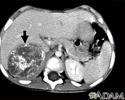Neuroblastoma
Cancer - neuroblastoma
Neuroblastoma is a very rare type of cancerous tumor that develops from nerve tissue. It usually occurs in infants and children.
Causes
Neuroblastoma can occur in many areas of the body. It develops from the tissues that form the sympathetic nervous system. This is the part of the nervous system that regulates body functions, such as heart rate and blood pressure, digestion, and levels of certain hormones.
Most neuroblastomas begin in the abdomen, in the adrenal gland, next to the spinal cord, or in the chest. Neuroblastomas can spread to the bones. Commonly affected bones include those in the face, skull, pelvis, shoulders, arms, and legs. It can also spread to the bone marrow, liver, lymph nodes, skin, and around the eyes (orbits).
The cause of the tumor is not known. Experts believe that a variant in a gene may play a role. Half of tumors are present at birth. Neuroblastoma is most commonly diagnosed in children before the age of 5 years. Each year, there are around 700 new cases in the United States. The disorder is slightly more common in boys.
In most people, the tumor has spread when it is first diagnosed.
Symptoms
The first symptoms are usually fever, a general sick feeling (malaise), and pain. There may also be loss of appetite, weight loss, and diarrhea.
Other symptoms depend on the site of the tumor, and may include:
- Bone pain or tenderness (if the cancer has spread to the bones)
- Difficulty breathing or a chronic cough (if the cancer has spread to the chest)
- Enlarged abdomen (from a large tumor or excess fluid)
- Flushed, red skin
- Pale skin and bluish color around the eyes
- Profuse sweating
- Rapid heart rate (tachycardia)
Brain and nervous system problems may include:
- Inability to empty the bladder
- Loss of movement (paralysis) of the hips, legs, or feet
- Problems with balance
- Uncontrolled eye movements or leg and feet movements (called opsoclonus-myoclonus syndrome, or "dancing eyes and dancing feet")
Exams and Tests
Your health care provider will examine your child. Depending on the location of the tumor:
- There may be a lump or mass in the abdomen.
- The liver may be enlarged, if the tumor has spread to the liver.
- There may be high blood pressure and a fast heart rate if the tumor is in an adrenal gland.
- Lymph nodes may be swollen.
X-ray or other imaging tests are done to locate the main (primary) tumor and to see where it has spread. These include:
- Bone scan
- Bone x-rays
- Chest x-ray
- CT scan of chest and abdomen
- MRI scan of chest and abdomen
Other tests that may be done include:
- Biopsy of the tumor
- Bone marrow biopsy
- Complete blood count (CBC) showing anemia or other abnormality
- Coagulation studies and erythrocyte sedimentation rate (ESR)
- Hormone tests (blood tests to check levels of hormones such as catecholamines)
- MIBG scan (imaging test to confirm the presence of neuroblastoma)
- Urine 24-hour test for catecholamines, homovanillic acid (HVA), and vanillylmandelic acid (VMA)
Treatment
Treatment depends on:
- Location of the tumor
- How much and where the tumor has spread
- The person's age
In certain cases, surgery alone is enough. Often, though, other therapies are needed as well. Anticancer medicines (chemotherapy) may be recommended if the tumor has spread. Radiation therapy may also be used.
High-dose chemotherapy, autologous stem cell transplantation, and immunotherapy are also used.
Support Groups
You can ease the stress of illness by joining a cancer support group. Sharing with others who have common experiences and problems can help you and your child not feel alone.
Outlook (Prognosis)
The outcome varies. In very young children, the tumor may go away on its own, without treatment. Or, the tissues of the tumor may mature and develop into a non-cancerous (benign) tumor called a ganglioneuroma, which can be surgically removed. In other cases, the tumor spreads quickly.
The response to treatment also varies. Treatment is often successful if the cancer has not spread. If it has spread, neuroblastoma is harder to cure. Younger children often do better than older children.
Children treated for neuroblastoma may be at risk of getting a second, different cancer in the future.
Possible Complications
Complications may include:
- Spread (metastasis) of the tumor
- Damage and loss of function of involved organs
When to Contact a Medical Professional
Contact your provider if your child has symptoms of neuroblastoma. Early diagnosis and treatment improves the chance of a good outcome.
References
Dome JS, Rodriguez-Galindo C, Spunt SL, Santana VM. Pediatric solid tumors. In: Niederhuber JE, Armitage JO, Kastan MB, Doroshow JH, Tepper JE, eds. Abeloff's Clinical Oncology. 6th ed. Philadelphia, PA: Elsevier; 2020:chap 92.
National Cancer Institute website. Neuroblastoma treatment (PDQ) - health professional version. www.cancer.gov/types/neuroblastoma/hp/neuroblastoma-treatment-pdq. Updated September 11, 2024. Accessed October 28, 2024.
Review Date: 10/14/2024





















